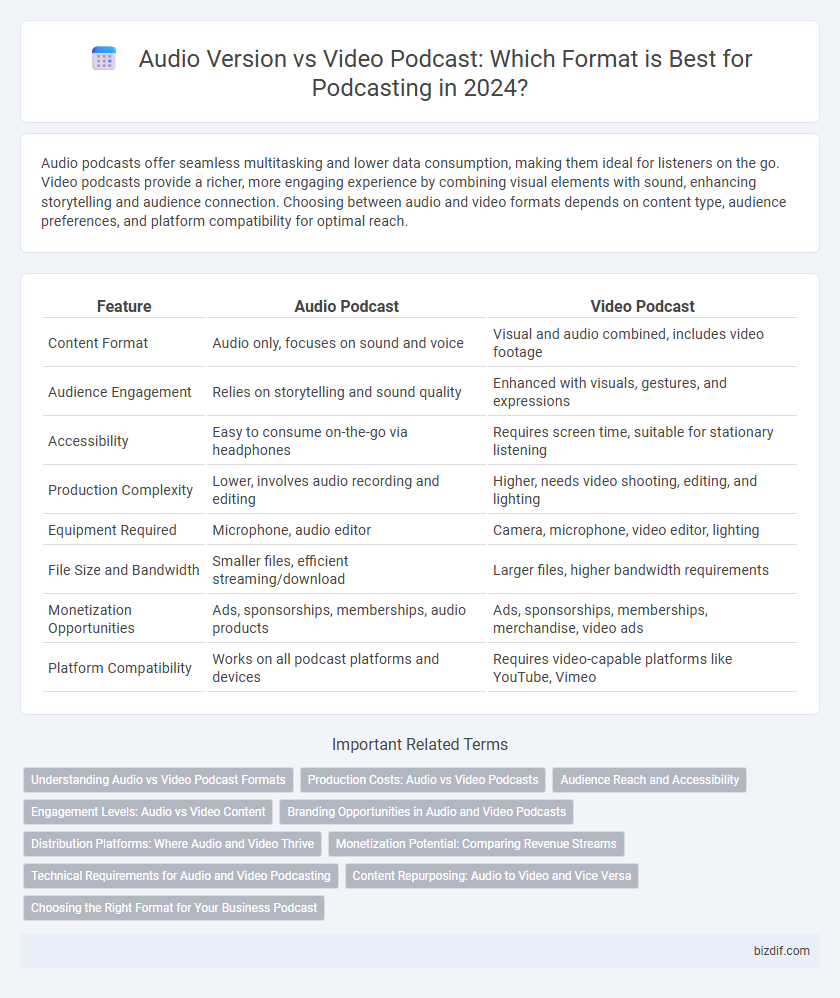Audio podcasts offer seamless multitasking and lower data consumption, making them ideal for listeners on the go. Video podcasts provide a richer, more engaging experience by combining visual elements with sound, enhancing storytelling and audience connection. Choosing between audio and video formats depends on content type, audience preferences, and platform compatibility for optimal reach.
Table of Comparison
| Feature | Audio Podcast | Video Podcast |
|---|---|---|
| Content Format | Audio only, focuses on sound and voice | Visual and audio combined, includes video footage |
| Audience Engagement | Relies on storytelling and sound quality | Enhanced with visuals, gestures, and expressions |
| Accessibility | Easy to consume on-the-go via headphones | Requires screen time, suitable for stationary listening |
| Production Complexity | Lower, involves audio recording and editing | Higher, needs video shooting, editing, and lighting |
| Equipment Required | Microphone, audio editor | Camera, microphone, video editor, lighting |
| File Size and Bandwidth | Smaller files, efficient streaming/download | Larger files, higher bandwidth requirements |
| Monetization Opportunities | Ads, sponsorships, memberships, audio products | Ads, sponsorships, memberships, merchandise, video ads |
| Platform Compatibility | Works on all podcast platforms and devices | Requires video-capable platforms like YouTube, Vimeo |
Understanding Audio vs Video Podcast Formats
Audio podcasts offer flexibility and easy consumption, allowing listeners to engage while multitasking or on-the-go, which enhances accessibility and audience reach. Video podcasts provide visual engagement that can deepen connection through facial expressions, demonstrations, and on-screen graphics, supporting complex storytelling and brand identity. Choosing between audio and video formats depends on target audience preferences, content type, and distribution goals to optimize listener experience and platform compatibility.
Production Costs: Audio vs Video Podcasts
Audio podcasts typically incur lower production costs due to minimal equipment needs, reduced editing time, and simpler post-production processes compared to video podcasts. Video podcasts require investment in cameras, lighting, video editing software, and often larger production teams, increasing both time and financial resources. Budget-conscious creators often prioritize audio formats to maximize content output while minimizing expenses.
Audience Reach and Accessibility
Audio podcasts reach a broader audience due to their ease of consumption during activities like commuting or exercising, requiring only basic audio devices. Video podcasts demand higher data usage and visual attention, limiting accessibility for listeners on the go or in low-bandwidth areas. Consequently, audio formats generally offer greater audience reach and accessibility compared to video podcasts.
Engagement Levels: Audio vs Video Content
Audio podcasts often drive higher engagement through multitasking compatibility and stronger narrative immersion, while video podcasts enhance viewer interaction by providing visual cues and personality expression. Studies show video content can increase retention rates by up to 80%, yet audio formats sustain longer average listening durations due to convenience. Integrating both formats strategically boosts overall audience engagement by catering to diverse consumption preferences.
Branding Opportunities in Audio and Video Podcasts
Audio podcasts offer unique branding opportunities through immersive sound design, host voice personalization, and sponsor integrations that foster strong listener loyalty. Video podcasts enhance brand visibility by combining visual elements like logos, on-screen graphics, and facial expressions, which create a richer storytelling experience and increase audience engagement. Both formats enable targeted advertising, but video content leverages platforms like YouTube for greater shareability and cross-channel brand amplification.
Distribution Platforms: Where Audio and Video Thrive
Audio podcasts dominate platforms like Spotify, Apple Podcasts, and Google Podcasts, offering vast reach with easy streaming and offline listening options. Video podcasts thrive on YouTube and Vimeo, leveraging visual engagement and broader discoverability through video search algorithms. Both formats benefit from social media sharing, but video podcasts often capitalize on platforms optimized for video content to attract diverse audiences.
Monetization Potential: Comparing Revenue Streams
Audio podcasts generate consistent revenue through dynamic ad insertions, sponsorships, and listener donations, benefiting from lower production costs and easier consumption on-the-go. Video podcasts offer diversified monetization channels such as YouTube ad revenue, brand partnerships, merchandise sales, and viewer memberships, leveraging visual engagement and platform algorithms for increased visibility. While video podcasts require higher production effort, their multiple revenue streams often surpass audio-only formats in profitability and audience reach.
Technical Requirements for Audio and Video Podcasting
Audio podcasts require minimal technical equipment, typically just a quality microphone, audio editing software, and hosting services, making production more accessible and cost-effective. Video podcasts demand higher technical specifications, including cameras, lighting, video editing software, and greater bandwidth for recording and streaming or uploading high-resolution content. The complexity of video production entails longer post-production times and more robust hardware to ensure synchronization of audio and visuals, affecting both setup and distribution logistics.
Content Repurposing: Audio to Video and Vice Versa
Repurposing podcast content between audio and video formats enhances audience reach and engagement by adapting to different consumption preferences. Converting audio podcasts into video versions with dynamic visuals, such as waveforms, images, or subtitles, increases shareability on platforms like YouTube and social media. Conversely, extracting high-quality audio from video podcasts enables distribution through popular audio channels like Spotify and Apple Podcasts, maximizing content accessibility and monetization opportunities.
Choosing the Right Format for Your Business Podcast
Audio podcasts offer convenience and simplicity, allowing listeners to engage while multitasking, making them ideal for commuting or exercising audiences. Video podcasts enhance visual engagement, showcasing interviews, demonstrations, or brand personality, which can boost audience connection and social media reach. Selecting the right format depends on your business goals, target audience preferences, and content type to maximize listener retention and brand impact.
Audio version vs video podcast Infographic

 bizdif.com
bizdif.com